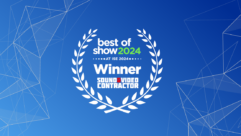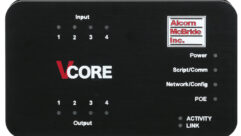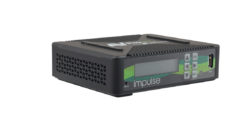
Tablets as GUI
Jul 24, 2013 5:28 PM,
By Patrick Barron
Consumer technology revolutionizes pro AV control systems.

For many years, user interfaces for control systems have consisted of keypads and touchpanels that are made by manufacturers of control system hardware. Keypads come in many shapes, sizes, and have various colors and buttons available. Touchpanels are available in a wide variety of sizes, aspect ratios, and can be found in full color, grayscale, and monochrome. Touchpanels available from control manufacturers are proprietary in their design and architecture. Special software that is only available from the control system companies is required to develop and program the system. Due to the proprietary nature of the hardware needed and expenses of materials used in creating the panels, the final touchpanel product is expensive when compared to other mass-manufactured touchscreens available to consumers.
When Apple introduced the iPad several years ago, a new kind of touchscreen became affordable to the general consumer market, and by extension to most business markets, as well. This product started a trend of small, affordable touchscreens from other manufacturers. These particular touchscreens were designed with consumers in mind and not specifically designed for control system applications. Affordability of these screens caused control system manufacturers to evaluate potential applications where these types of panels might be used as a graphical user interface (GUI) for a control system. The cost of iPads and Android tablets is significantly less than a typical touchpanel of an equivalent size. Never before has a 10in. full-color touchscreen been so affordable. Control system manufacturers, such as AMX and Crestron, have been able to develop applications to run on iPads and tablets. These applications communicate with the control master processors, effectively creating a touchpanel out of an iPad. There are several effective options for an iPad to interface with a control system. The number of control system companies that offer solutions using an iPad could never be covered within the confines of a single article, so no slight is intended to companies that are not mentioned by name. Some control system companies—such as Crestron, AMX, ELAN, Savant, Control4, HRS Control, Global Cache, URC, and RTI—have created proven and reliable applications that interface an iPad to their control system processor. Pricing for system solutions vary from inexpensive to as high as you want to spend depending on which vendor is used.
We will focus on iPads and Android tablets interfaces offered by two of the largest control system manufacturers: Crestron and AMX. For purposes of this discussion, the terms “iPad” and “tablet” will be used interchangeably to represent the same concept.
CRESTRON AND AMX APPS
Crestron has written a family of applications called Crestron Mobile, which are targeted for iPad and tablet uses. Mobile Pro is a control app for the iPhone and iPod touch, while Mobile PRO-G is specifically a control app for the iPad.
AMX’s Authorized Product Partner Touch Panel Control wrote the company’s native application, TPControl. A version of TPControl is available for iOS products and another version is available for Android tablets. An alternative option for AMX control is to use a VNC application (several are available including iTeleport) to interface to a G4 touchpanel or a virtual touchpanel called NXV-300. AMX’s NXV-300 is a hardware device that works with an iPad/tablet VNC application to provide three simultaneous users the ability to operate a set of touchpanel pages that have been loaded.
Tablets as GUI
Jul 24, 2013 5:28 PM,
By Patrick Barron
Consumer technology revolutionizes pro AV control systems.

AMX NXV-300
APP FUNCTIONALITY
Many functions that both AMX and Crestron tablet interfaces perform are functionally identical to a touchpanel. All standard operations of a touchpanel can be implemented on a tablet using similar methods as a normal touchpanel. Buttons can be pressed, graphics can be loaded, and variable text and bar graphs can be used just like a normal panel. Subpages and popup pages can be used in a similar fashion, and the same development environment (VTPro for Crestron and TPDesign4 for AMX) is used to develop pages. From a programming standpoint, a software developer who is familiar with designing a standard touchpanel will have no problem developing an interface to use with an iPad. A project created in VTPro or TPDesign4 can easily be converted for use on an iPad. This maintains consistent styling and functionality between all touchpanel interfaces in a system.
While development is similar, significant differences occur when loading programs to a tablet device. A traditional touchpanel can be loaded directly from the touchpanel designer application. The process for loading a tablet is different but not difficult using Crestron’s version. Loading an AMX NVX-300 virtual touchpanel is identical to loading a normal panel once an NXV-300 has been set up properly. The process for loading a TPControl application onto a tablet is relatively easy, as well, provided that a live Internet connection is available on the jobsite.
A few limitations should be considered when using the iPad as a primary control interface. One particular factor can be considered both an advantage and a disadvantage. The fact that an iPad is not a dedicated control interface can be a disadvantage when trying to make a quick adjustment to a parameter on the AV system, such as volume. With a traditional touchpanel, a quick tap would wake up the panel, and buttons to control the system would be immediately available. When using an iPad, the control interface is an application. Users might have to scroll through multiple pages to find the app. Then they would have to launch the app and wait until the app connects to the control system master processor. After the control screen comes up, the user is able to access the desired buttons to make adjustments. In a time-critical environment where a quick audio adjustment needs to be made, the delay of several seconds to initiate the application could be detrimental. Another factor to note is how the basic operation of the screen and button presses on an iPad feel different than using a dedicated touchpanel. Because an iPad is designed primarily for a different type of use and has multi-touch capability, the standard button press is not quite as responsive as using a standard AMX or Crestron touchpanel. The press of a button has to be more deliberate for the press to register. Some commands, such as volume ramping or moving a camera, might be more difficult for a user who has become accustomed to how a touchpanel feels when being used.
TABLET ADVANTAGES
Just as how an iPad not being a dedicated control interface can be a problem, the fact that it is a multi-purpose device can be a significant advantage, as well. There are literally millions of applications that have been developed for both iPad and Android tablets. While playing a game with friends on your tablet, you can check the Internet for the latest sports scores or stock market updates, and in the next moment, you can change the channel or fast forward a movie without leaving the couch. The power available in such a small device to allow so many functions is something that can be utilized to enhance the ease of use of a control system.
There are undeniably a large number of positive aspects to using an iPad or Android tablet as a control interface. In commercial and professional settings, iPads offer longer battery life, better ergonomics, and a sleeker form factor than a traditional touchpanel. A significant factor is the cost of the tablet device compared to a touchpanel. An AMX 9in. wireless touchpanel of comparable size to an iPad has a MSRP of $5,500. A large 8in. wireless Crestron touchpanel has an MSRP of $3,800. Compare this cost to the price of a 9.7in. iPad 2 for $399 or a Samsung Galaxy Tab 10.1in. with a price of $349. Another advantage of using a tablet is that many customers already have their own devices, so hardware cost is negligible.
The cost of substituting an iPad for a touchpanel goes beyond the actual price of the device itself. Costs of software applications used on tablets vary depending on the manufacturer. With Crestron, the Mobile Pro application is $99. Mobile Pro will allow an iPad to function as an independent touchpanel. For this cost, an unlimited number of iPads can be set up to operate as touchpanels, provided they are all on the same iTunes account. In schools, corporations, or even residences with a consolidated iTunes account, this could mean dozens of touchpanels for less than $100 in total cost if the iPads were previously owned by the client.
Tablets as GUI
Jul 24, 2013 5:28 PM,
By Patrick Barron
Consumer technology revolutionizes pro AV control systems.

Crestron Mobile Pro
For an AMX system, any VNC client will work to connect with a Modero G4 touchpanel because each panel has a built-in VNC server. This VNC server is included at no additional cost and no additional license fees are needed. A VNC application running on a tablet will be able to connect to the G4 touchpanel to provide a mirrored control interface on the tablet. Some VNC applications such as iTeleport have been optimized to operate as an AMX touchscreen interface. The iTeleport application is around $20. If an AMX touchpanel is not part of a system, and a dedicated iPad control interface is needed, other options exist to enable this control with AMX. A NXV-300 will provide a hardware interface to allow the VNC connection on the iPad. The NXV-300 is a virtual touchpanel that has the same capabilities as a touchpanel minus a built-in screen. The only interface to the NXV-300 is through a network connection. MSRP cost of the NXV-300 is $990.
The TPControl application from Touch Panel Control enables Apple mobile devices and tablets to transform into fully functional touchpanels for controlling AMX systems, and it has a MSRP of close to $1,300 for a single license. The process for using TPControl requires an application called TPTransfer for realtime license authentication and transferring of the TPDesign4 files to the mobile device. The process of license authentication requires a live Internet connection, which is not always feasible outside of a development or test environment. Compared to using the NXV-300, which can be loaded while on a jobsite that has no Internet connection, the TPControl solution can be almost impossible to implement if an Internet connection is not present. If using TPControl, it would be best to have the iPad or tablet that will be used in advance so the license could be authenticated while in the programmer’s office.
In my personal experience, around 90 percent of the jobs where I have worked did not have Internet access. Because in most cases, it was a construction site where the network was not installed. In other cases, it was a school, law firm, hospital, or secure government facility where network access was highly restricted to authorized personnel. Because the iPad is a personal device that has many other functions, the client is typically using the tablet on a regular basis. The occasion has been nonexistent when I had access to the client’s iPad in advance of being onsite to load the final code. Without possession of the client’s tablet device in advance while in an environment such as the programmer’s office, the ability of the TPControl application to validate the license would not function, thus rendering the file unable to load to the iPad at a jobsite.
While the TPControl application costs more than the NXV-300, it does have many features such as VoiceControl using speech-to-text and text-to-speech functionality, AppControl to launch installed applications directly from TPControl, and Intercom to have a conversation from TPControl to devices such as AMX Intercom-enabled touchpanels. If cost is not a factor and the difficulty of initially loading the file with a validated license could be overcome, the TPControl solution can not only replace a touchpanel, it can enable additional functions that are unique to the iPad and are not available in a touchpanel.
APP PROS AND CONS
All three of the solutions discussed—Crestron Mobile Pro, AMX NXV-300, and Touch Panel Control TPControl application—are all able to transform an ordinary iPad or tablet into an easy-to-use interface providing realtime, touch control of AV systems, lighting, shades, room temperatures, and more. There are strengths and weaknesses to each solution.
Crestron’s Mobile Pro provides a formidable replacement for a traditional touchpanel at a price point that dramatically lowers a control system’s cost of ownership. If multiple touchpanels are used in a system, this cost difference could be a factor not only in whether to use a tablet versus touchpanel, but it could also influence the user’s decision to use Crestron as a solution or take a different approach.
AMX’s VNC server, available in all of the company’s Modero G4 panels, allows the use of an iPad as a touchpanel if the customer already has an iPad and a Modero panel is already part of the system. This can provide a simple and inexpensive way for the customer to have a duplicate user interface through an existing Modero touchpanel. The drawback is that some types of panels or hardware devices, such as the NXV-300, must exist to facilitate the VNC connection.
Finally, TPContol is able to provide many features not available in a traditional touchpanel. But the limitations imposed by the method of validating the license raise questions as to how viable this solution would be in a traditional jobsite environment where Internet access is not readily available. The cost difference in the TPControl application compared to Mobile Pro is a factor to consider when deciding what type of iPad interface to implement. In any case, the user can have a fully functioning, powerful, and capable control system interface at a fraction of the cost of a touchpanel using any of these solutions.










